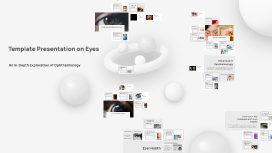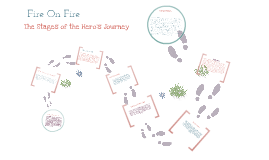Template Presentation on Eyes
Transcript: Visual Pathway Light enters the eye through the cornea, passes through the lens, and hits the retina. The retina converts light into neural signals, which travel via the optic nerve to the visual cortex in the brain. Differences Between Animal and Human Eyes Layers of the Eye The eye is comprised of three main layers: the fibrous tunic (sclera and cornea), the vascular tunic (choroid, ciliary body, and iris), and the inner layer (retina). Each layer serves specific functions essential for vision. Human eyes are generally round, enabling detailed vision and color perception, while some animals have differently shaped eyes for specific adaptations. For example, eagles have higher visual acuity while nocturnal animals possess larger pupils for low-light visibility. Retinal Detachment Retinal detachment occurs when the retina separates from the back of the eye, leading to vision loss. It is a medical emergency requiring prompt treatment, which may include laser surgery or cryotherapy to secure the retina back in place. Common Terminology Function of Each Component Conjunctivitis Key terms include myopia (nearsightedness), hyperopia (farsightedness), and astigmatism, which describe common vision defects. Understanding this vocabulary is essential for discussing eye health and vision care. The cornea refracts light, the lens adjusts focus, and the retina processes images. The optic nerve then transmits visual data to the brain, where it is interpreted as sight. Conjunctivitis, or pink eye, signifies inflammation of the conjunctiva, commonly caused by allergies, bacteria, or viruses. Symptoms can include redness, itching, and discharge; treatment varies based on the cause, with proper hygiene being crucial for prevention. Understanding Eye Anatomy Diabetic Retinopathy The human eye is a complex organ that not only captures light but also converts it into visual information. Its intricate structure supports essential functions and allows us to perceive the world around us. Diabetic retinopathy is a complication of diabetes that affects the eyes, characterized by damage to the blood vessels in the retina. It can lead to vision impairment and blindness; timely screening and effective diabetes management are essential. Structure of the Eye Macular Degeneration Eye-related Diseases The eye consists of several key components: the cornea, lens, retina, and optic nerve. Each part plays a unique role in focusing light and relaying images to the brain for interpretation. Macular degeneration is a leading cause of vision loss in older adults, resulting from damage to the macula. It affects central vision, making tasks like reading and recognizing faces challenging; treatment options include injections and lifestyle changes. Understanding the impact of eye-related diseases is crucial for maintaining vision health. Common conditions such as cataracts and glaucoma can significantly affect quality of life and lead to vision loss if not addressed promptly. Cataracts Glaucoma Cataracts occur when the lens of the eye becomes cloudy, leading to decreased vision. It commonly affects older adults, with surgery being the only effective treatment, resulting in nearly 98% improvement in vision post-procedure. Glaucoma is an eye condition characterized by increased intraocular pressure, which can damage the optic nerve and lead to vision loss. Regular eye exams are vital for early detection and management of this silent condition. Future Trends in Eye Care Template Presentation on Eyes The future of eye care is pointing towards personalized medicine, with treatments tailored to individual genetic profiles. Additionally, the integration of artificial intelligence in vision diagnostics aims to enhance accuracy and speed in patient assessments. Advances in Ophthalmology An In-Depth Exploration of Ophthalmology Latest Research Findings The Role of Light Recent advancements in ophthalmology have significantly improved diagnosis, treatment, and patient outcomes. Innovative technologies and surgical techniques are redefining eye care, ensuring better management of various eye conditions. Cutting-edge research has unveiled new insights into genetic eye diseases, paving the way for gene therapies. Notably, studies show potential in treating inherited retinal diseases with advancements in CRISPR technology, which may restore vision in affected individuals. Light is essential for vision, influencing visual clarity and color. Variations in light intensity, spectrum, and angle affect how objects appear. The eyes adapt to varying light conditions through processes like pupillary constriction and dilation. Treatments for Common Eye Conditions Surgical Innovations Innovative treatments for common conditions like dry eye syndrome now include unique eye drops containing lipids to restore tears. Additionally, anti-VEGF injections are highly effective for treating wet macular degeneration, preventing vision loss. Recent advancements in surgical techniques,

















